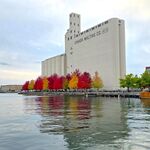syn
Senior Member
City core attracting a wealthier, better educated, childless population
Oct 26, 2007 07:42 AM
John Spears
CITY HALL BUREAU
The explosion of high-rise condominiums in Toronto's downtown isn't an illusion: The population of the downtown core has grown by 65 per cent in the past 30 years, and nearly 10 per cent in the past five.
That makes downtown Toronto one of the fastest growing communities in Greater Toronto, says a new report by the city's planning staff.
And the newer residents are wealthier, better educated and less likely to have children than their downtown neighbours.
Downtown may be the fastest growing area of the city, but it's not sucking the life out of other neighbourhoods, said Barbara Leonhardt, director of policy and research in the planning department.
"I don't believe it's at the expense of other areas," she said in an interview.
"We're seeing growth in other areas as well – all of the areas where we want it to happen: the North York centre, the Scarborough centre, the Etobicoke centre and along the avenues."
Still, downtown growth was dramatic: 17,000 housing units were built in the area between 2001 and 2006. The downtown population stood at nearly 169,000 last year, up from 102,000 five years earlier.
The sprouting towers – and applications for many more in the approval pipeline – prompted planners to gather more information about who's living downtown and what services are needed, Leonhardt said.
Planners sent 15,550 questionnaires to residents in the area bounded by Lake Ontario, the Don Valley, Bathurst St. and Dupont St.-Rosedale Valley Rd.
Eighteen per cent responded – 2,260 households – meaning the survey should be accurate within 1.7 percentage points.
Most of the new downtown residents didn't move that far from their old homes.
Of those who had moved within the past five years, 70 per cent came from another Toronto address; and of that group, eight out of 10 had moved from another downtown home or one within 5 kilometres.
The survey zeroed in on who's living in housing built since 2001, comparing these generally newer downtown residents with those living in pre-2001 dwellings.
Only 4 per cent of households in the newer units have children, compared with 12 per cent in the older housing, the survey found.
The newer units are dominated by adults 25 to 39; older units have "a more diverse distribution," including more children, older adults and significantly more seniors.
The shrinking child population downtown, and dwindling school enrolment, have been flagged as an issue by Councillor Adam Vaughan (Ward 20, Trinity-Spadina).
Leonhardt said that since people are tending to have children later in life, it's possible many young downtown residents ultimately will have children.
"What is an issue, I think, is housing that's suitable for people when they decide to have children: Is it being built?" she said.
"That's something we are looking at – whether or not we need to look at interventions in the market to see that kind of housing built."
Income levels are sharply different between the older and newer housing groups.
In the older housing, 51 per cent of households have income under $60,000. In the post-2001 units, only 29 per cent of households have incomes under $60,000.
And 83 per cent of residents in newer housing are in the labour force – nearly all of them in full-time jobs – compared with 67 per cent in older housing units, the same rate for the city as a whole.
http://www.thestar.com/News/GTA/article/270694
Oct 26, 2007 07:42 AM
John Spears
CITY HALL BUREAU
The explosion of high-rise condominiums in Toronto's downtown isn't an illusion: The population of the downtown core has grown by 65 per cent in the past 30 years, and nearly 10 per cent in the past five.
That makes downtown Toronto one of the fastest growing communities in Greater Toronto, says a new report by the city's planning staff.
And the newer residents are wealthier, better educated and less likely to have children than their downtown neighbours.
Downtown may be the fastest growing area of the city, but it's not sucking the life out of other neighbourhoods, said Barbara Leonhardt, director of policy and research in the planning department.
"I don't believe it's at the expense of other areas," she said in an interview.
"We're seeing growth in other areas as well – all of the areas where we want it to happen: the North York centre, the Scarborough centre, the Etobicoke centre and along the avenues."
Still, downtown growth was dramatic: 17,000 housing units were built in the area between 2001 and 2006. The downtown population stood at nearly 169,000 last year, up from 102,000 five years earlier.
The sprouting towers – and applications for many more in the approval pipeline – prompted planners to gather more information about who's living downtown and what services are needed, Leonhardt said.
Planners sent 15,550 questionnaires to residents in the area bounded by Lake Ontario, the Don Valley, Bathurst St. and Dupont St.-Rosedale Valley Rd.
Eighteen per cent responded – 2,260 households – meaning the survey should be accurate within 1.7 percentage points.
Most of the new downtown residents didn't move that far from their old homes.
Of those who had moved within the past five years, 70 per cent came from another Toronto address; and of that group, eight out of 10 had moved from another downtown home or one within 5 kilometres.
The survey zeroed in on who's living in housing built since 2001, comparing these generally newer downtown residents with those living in pre-2001 dwellings.
Only 4 per cent of households in the newer units have children, compared with 12 per cent in the older housing, the survey found.
The newer units are dominated by adults 25 to 39; older units have "a more diverse distribution," including more children, older adults and significantly more seniors.
The shrinking child population downtown, and dwindling school enrolment, have been flagged as an issue by Councillor Adam Vaughan (Ward 20, Trinity-Spadina).
Leonhardt said that since people are tending to have children later in life, it's possible many young downtown residents ultimately will have children.
"What is an issue, I think, is housing that's suitable for people when they decide to have children: Is it being built?" she said.
"That's something we are looking at – whether or not we need to look at interventions in the market to see that kind of housing built."
Income levels are sharply different between the older and newer housing groups.
In the older housing, 51 per cent of households have income under $60,000. In the post-2001 units, only 29 per cent of households have incomes under $60,000.
And 83 per cent of residents in newer housing are in the labour force – nearly all of them in full-time jobs – compared with 67 per cent in older housing units, the same rate for the city as a whole.
http://www.thestar.com/News/GTA/article/270694




